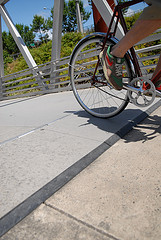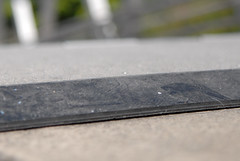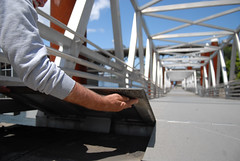Last week I joined a Portland Parks & Recreation staffer for a visit to the Eastbank Esplanade. Our intention was to see what, if anything, could be done to smooth out a series of bumps that exist on ramps leading to the floating portion of the trail.
The meeting came after I published a story on July 9th about the bumps. That story sparked over 200 comments that expressed a range of opinions about them. Many people said they are no problem at all (once you get used to them), while others felt the bumps should be fixed. The man featured in that story, Ron Richings, crashed and sustained a serious shoulder injury after the bumps caused a bungee cord attached to his bike to become dislodged and get caught in his wheel.
During our visit out at the site, Parks’ Central Support Services Manager Bob Downing demonstrated how the bumps are attached to a two-foot piece of metal on the edge of the ramps that moves up and down depending on the height of the tides in the river. The bumps are caused by a small, black rubber lip on those metal pieces. Those rubber lips are at about a 40-degree angle and they are jarring when rolled over by bicycle tires.
“Right now, they seem to be catching some people by surprise… We try to engineer out the surprise factor.”
— Bob Downing, Portland Parks Central Support Services Manager
As we observed people rolling over them (at 1:30 pm on a weekday), nearly everyone slowed down and rolled over them without issue. A few experienced riders even bunny-hopped them. Before Downing arrived, I asked several people what they thought about the bumps.
One man, an older gentleman in full lycra on high-end road bike said “They’re pretty harsh, but if we didn’t have them people would go too fast.” Another man, riding an old mountain bike with front suspension and knobby tires, said he’s used to them: “It’s just a bump… I get used to them. I get used to everything except for the cars.” A couple out for a leisurely spin on rental bikes said they definitely noticed the bumps: “Good thing we were going slow… They should definitely smooth them out.”
Downing acknowledged the “hassle” of rolling over the bumps and he’s aware that speeding by people on bikes is a major concern on the shared Esplanade path. But, according to Downing, the bumps weren’t installed to slow people down. “You try to stay away from hassle when you design facilities like this… and this isn’t the tool you’d use to slow people down.”
Upon inspecting the rubber bump, Downing said they have no immediate plans to change it. “Since it’s not broken, if we look at putting in a new rubber lip piece, we’d have to look at the importance of this relative to other priorities.”
That importance is based in part on whether or not the bumps led to a significant public safety hazard. Downing says they’d consider replacing the rubber piece (with ones that have a less severe angle) if the problem was larger then they currently think it is. But as of right now, Parks hasn’t gotten enough reports of injuries or damages to warrant such action.
I asked Downing how people would report incidents if they occur. He said 823-SAFE (7233) is an option, but that a better tool might be Parkscan. Parkscan is run by the City of Portland and allows citizens to report problems/observations within the Park system and have them routed directly to appropriate staff.
While redesigning or replacing the bumps is not on the table right now, Downing is looking into improved signage and possibly adding reflective striping to the bumps in order to warn people about them. “Right now, they seem to be catching some people by surprise… We try to engineer out the surprise factor.”
Downing said they had no idea these bumps were an issue, but that learning about them has been an important learning process for him and the Parks bureau as they work on current and future projects. He also wanted to stress that they don’t want to wait for a serious incident before addressing the bumps, but that right now these bumps haven’t been on their radar as even a minor issue. Before making any significant change or investment in a new design, Downing said, “We want to hear from the people we work for.”





